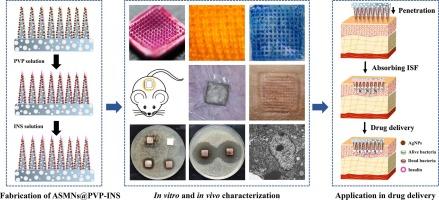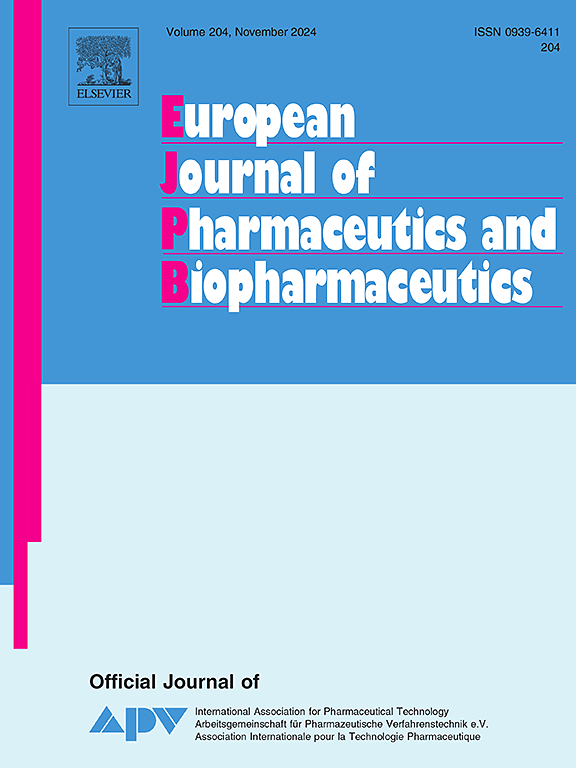用于胰岛素透皮给药的抗菌海绵微针的设计、制造和评价
IF 4.4
2区 医学
Q1 PHARMACOLOGY & PHARMACY
European Journal of Pharmaceutics and Biopharmaceutics
Pub Date : 2024-11-28
DOI:10.1016/j.ejpb.2024.114586
引用次数: 0
摘要
透皮给药系统前景光明,但其有效性往往受到皮肤屏障的限制。微针(MNs)通过在皮肤中创建微通道来改善药物的渗透性,但它们仍然面临感染风险和安全问题等挑战。为了克服这些挑战,设计了一种新型的聚乙烯吡咯烷酮(PVP)改性的抗菌海绵MNs (ASMNs@PVP-INS),用于胰岛素(INS)的输送。机械测试表明,这些纳米颗粒具有优异的机械强度,能够承受至少0.11 N /针而不破裂。体外药物渗透试验显示,MNs在6小时内持续释放超过75%的INS。在动物模型中,ASMNs@PVP-INS将初始血糖水平从22.4降低到5.72 mmol/L,有效地维持血糖控制超过6小时而不引起低血糖。此外,琼脂扩散试验表明,INS负载不会影响抗菌海绵纳米颗粒(ASMNs)的抗菌性能。皮肤刺激试验显示ASMNs@PVP-INS表现出轻度刺激(PII <;0.6), 8 h内皮肤损伤完全恢复。安全性评估显示对小鼠无明显毒性,生化指标在正常范围内,证实其具有良好的生物相容性。总之,ASMNs@PVP-INS有望成为一种新型的药物输送载体。本文章由计算机程序翻译,如有差异,请以英文原文为准。

Design, fabrication, and evaluation of antimicrobial sponge microneedles for the transdermal delivery of insulin
Transdermal drug delivery systems hold promise, but their effectiveness is often constrained by the skin’s barrier. Microneedles (MNs) improve drug permeability by creating micro-channels in the skin, yet they continue to face challenges such as infection risks and safety concerns. To overcome these challenges, a novel antimicrobial sponge MNs (ASMNs@PVP-INS) modified with polyvinylpyrrolidone (PVP) for insulin (INS) delivery was designed. Mechanical testing demonstrated that these MNs possess excellent mechanical strength, capable of withstanding at least 0.11 N per needle without rupture. In vitro drug penetration tests revealed that the MNs consistently released over 75 % of INS within a 6 h. In an animal model, ASMNs@PVP-INS reduced initial blood glucose levels from 22.4 to 5.72 mmol/L, effectively maintaining glucose control for more than 6 h without inducing hypoglycemia. Additionally, agar diffusion assays indicated that INS loading did not compromise the antimicrobial properties of antimicrobial sponge MNs (ASMNs). Skin irritation tests showed that ASMNs@PVP-INS exhibited mild irritation (PII < 0.6), with skin damage fully recovering within 8 h. Safety assessments indicated no significant toxicity to mice, with biochemical markers remaining within normal ranges, thereby confirming their good biocompatibility. In conclusion, ASMNs@PVP-INS hold promise as a novel drug delivery vehicle.
求助全文
通过发布文献求助,成功后即可免费获取论文全文。
去求助
来源期刊
CiteScore
8.80
自引率
4.10%
发文量
211
审稿时长
36 days
期刊介绍:
The European Journal of Pharmaceutics and Biopharmaceutics provides a medium for the publication of novel, innovative and hypothesis-driven research from the areas of Pharmaceutics and Biopharmaceutics.
Topics covered include for example:
Design and development of drug delivery systems for pharmaceuticals and biopharmaceuticals (small molecules, proteins, nucleic acids)
Aspects of manufacturing process design
Biomedical aspects of drug product design
Strategies and formulations for controlled drug transport across biological barriers
Physicochemical aspects of drug product development
Novel excipients for drug product design
Drug delivery and controlled release systems for systemic and local applications
Nanomaterials for therapeutic and diagnostic purposes
Advanced therapy medicinal products
Medical devices supporting a distinct pharmacological effect.

 求助内容:
求助内容: 应助结果提醒方式:
应助结果提醒方式:


